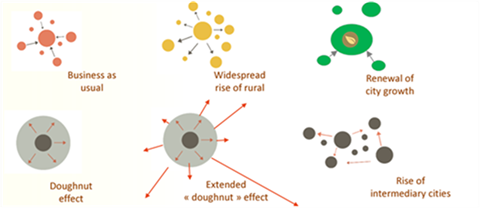Balanced territorial growth can be attained by enabling and leveraging the potential of intermediary cities. Polycentric urbanisation, which intermediary cities support, might result in a higher quality of urbanisation thanks to the limitation of over-densification and by distributing developmental returns on urbanisation throughout territories. Intermediate cities can "borrow size” and thus get agglomeration benefits without incurring agglomeration costs.
Urban systems
Cities are not homogeneous, and they are not in isolation. Instead, they are interlinked and linked with their surrounding rural areas. Their characteristics and the potential for their development and well-being depends on their size and the functions they play for their regions and countries. So, a systemic approach is needed to understand their interconnections and turn complementarities into synergies.
Our work on urban systems proposes place-based analysis and policy guidance to help cities of all sizes and their regions to address the multifaceted challenges cities face today, including addressing demographic change, advancing decarbonisation, and fostering social justice.

Key messages
Most rural settlements function with set connections to nearby cities. Those socio-economic ties call for good governance that local governments cannot manage on their own. Urban-rural partnerships can be a tool for a better policy targeting demographic, labour, public services-related and environmental dimensions of those linkages.
The quality of urbanisation can be strengthened by holistic strategic guidance and potent policy implementation and coordination mechanisms. Both those elements may benefit from being embodied within a National Urban Policy (NUP). NUPs differ significantly in terms of their institutional settings and sectorial policy coverage, and international debates and good-practice dissemination is important for the development of those complex documents.
The pandemic-induced changes of office work functioning had a strongly visible impact on the office real estate market, giving premiums for higher quality and discounting most of the less attractive offer, a part of which is being converted to other use. Taking those trends into account, policymakers need to monitor settlement patterns and their reaction towards those changes in equilibrium. The switches in spatial interdependencies between the places of working and living, if important enough, should be leveraged for a more balanced use of urban areas.
Context
Large cities are growing faster than smaller ones
In G7 countries, the population in metropolitan areas over 1.5 million people grew by almost 8% between 2006 and 2018 but declined by 1% in metropolitan areas with fewer than 500 000 inhabitants.

Balanced territorial development is a key goal for national urban policies
Globally, 55% of country national urban policy documents have a balanced territorial and urban development among their main goals.
Related publications
Programmes
-
Acknowledging and supporting intermediary cities can be the key to fostering territorially balanced development.Learn more
-
The OECD has set up an ambitious programme to support cities and regions to develop, implement and monitor strategies to achieve the Sustainable Development Goals (SDGs).Learn more
-
The OECD Principles on Urban Policy consolidate the lessons from the past 20+ years of work on cities to guide policymakers in building smart, sustainable and inclusive cities. The Implementation Toolkit helps use the Principles as a driver of policy reform.Learn more
-
The OECD contributes to the development, monitoring, and implementation of National Urban Policy (NUP) by joining hands with global stakeholders to foster debate, share expertise, build capacity, and support national governments in advancing their National Urban Policy processes.Learn more
-
Cities and regions play a pivotal role in climate action and resilience. This OECD programme supports cities, regions and countries in their efforts to accelerate the net-zero transition and adapt to the risks and impacts posed by climate change.Learn more
-
Implementing a place-based approach to decarbonise buildings is key to developing sustainable, inclusive and resilient cities and regions.Learn more
Related policy issues
-
Along with greater opportunity, city life has increasingly meant housing unaffordability, substandard quality, and overcrowding. As the world grows more urban, governments must find creative ways to provide affordable, quality, and sustainable housing for all.Learn more
-
Improving people's well-being requires sound evidence-based policies. We produce indicators for regions, cities and local areas in all areas of well-being. We promote international comparability, as well as the use of cutting-edge methods and new sources of data. Our network of experts advises on best practices for the production and use of high-quality statistics.Learn more
-
Climate hazards have always affected African territories, but climate change is now increasing their variability and the continent's vulnerability. With rapid population growth and urbanisation, African cities need to anticipate these changes to improve their preparedness. Positioned at the forefront of the response to climate change, African cities have a key role to play in ensuring the future viability, resilience and sustainability of these territories.Learn more
-
Today, cities demand almost two-thirds of global energy, produce up to 80% of greenhouse gas emissions and 50% of global waste. The circular economy is based on three principles: i) design out waste and pollution; ii) keep products and materials in use; and iii) regenerate natural systems. It can provide a policy response to cope with the above challenges, as a driver for economic growth, jobs and environmental quality.Learn more
-
Brussels Blueprint for affordable cities and housing for all flyerLearn more




